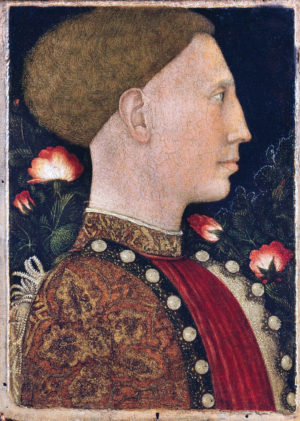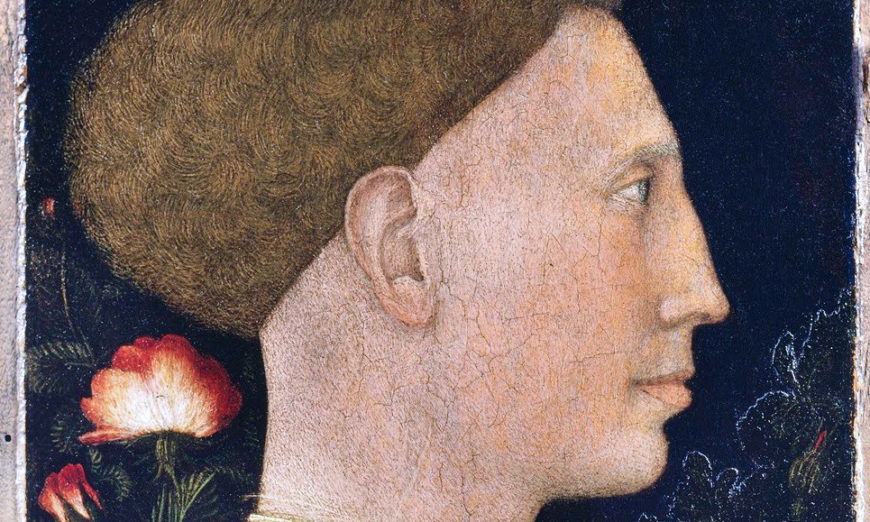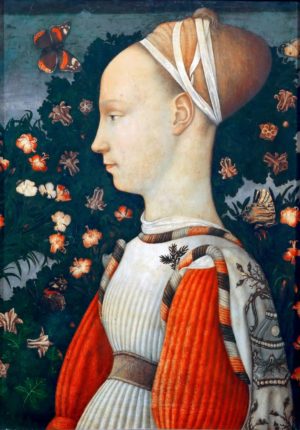Pisanello’s portrait of Leonello d’Este—Marquis of Ferrara—shows the ruler at his best. Leonello’s chiseled features are shown in profile, his aquiline nose and flawless creamy skin are set against a blue background (which has darkened over time). As appropriate for a man whose name means “little lion” in Italian, Leonello’s golden curls are shown in a mane-like bouffant. His chest, slightly angled towards the viewer, is puffed out, emphasizing his upright posture and showing off his richly brocaded jacket with buttons recalling military costume. Brave and proud like a lion, Leonello is also presented as a man of refinement and grace, ideas communicated by his elegant features and the delicate roses painted behind him. Like a social media post, this is all a carefully constructed fiction. Was this what Leonello really looked like? Is this what he was like? Probably. Sort of. It’s complicated.
Portraits are seductive. They entice us to see the sitter (the person portrayed in the image) in a particular way, to understand the fictional presence presented as their “true” self. In fact, Italian renaissance patrons, like Leonello, regularly asked to be “portrayed as if by nature” (ritratto al naturale), which might seem to imply that they sought a direct representation of what they looked like in life, in other words, in nature. Such was not the case. To imitate nature did not mean precise replication of a sitter’s visual features, flaws and all. A good portrait painter—like a good PR representative—knew that what was required was an idealized depiction, one that was recognizably the person portrayed, but also moderated (think: filtered) to present the sitter at his or her best according to social expectations. For Leonello, a military captain and ruler of a powerful state, this meant emphasizing his ideal masculinity, his agility of body and mind, as well as his inherent nobility and right to rule.
Pisanello’s portrait was cutting edge at the time of its creation. As a genre of art, autonomous portraiture (images solely dedicated to recording the features of a living or recently deceased person) was revitalized in the early fifteenth century. Although a popular art form in the ancient Roman world, such depictions largely disappeared, revived by early renaissance interests in ancient Greek and Roman art and celebrating the individual. Patrons were conscious of the power of portraiture to preserve memory, an idea articulated by Leon Battista Alberti in his treatise, On Painting (1435/6):
Painting contains a divine force which not only makes men present, as friendship is said to do, but moreover makes the dead seem almost alive…Even after many centuries they are recognized with great pleasure and with great admiration for the painter…the face of a man who is already dead certainly lives a long life through painting.Leon Battista Alberti, On Painting (1435/6) Book II. 25
Portraiture was initially reserved for the ruling classes and most of our earliest surviving autonomous portraits are associated with courts.
This ties into the primary function of portraiture: commemoration. Powerful men like Leonello d’Este wanted their features preserved for posterity, they wanted their presence felt even in their absence. Portraits were like stand-ins for the sitter, surrogate selves that could manifest the presence of the person depicted. As such, portraits were often given as diplomatic gifts or used in marriage negotiations. Pisanello’s portrait of Leonello’s younger sister, Ginevra d’Este, was created to celebrate her marriage to Sigismondo Malatesta, ruler of Rimini, and the resulting political alliance between Ferrara and Rimini.
Over time, the art of portraiture was adopted by members of the rising merchant class who sought to emulate the practices of the aristocracy. Still, the genre remained the privilege of the wealthy—only those of significant social and financial resources had their features recorded in portraiture.
Notably, Leonello is shown to us in profile. The rigidity of this format served multiple purposes. The profile presentation implied a lack of reciprocity between sitter and viewer: we gaze upon the visage of the ruler who is socially distanced from us, occupying an inaccessible and ideal realm. As an art form centered on commemorating the social status of the rich and powerful, the profile format had a desirable socially distancing effect (we see him, but he’s really not of our world . . . just as we all know that we aren’t really invited into the Kardashian household on TV).
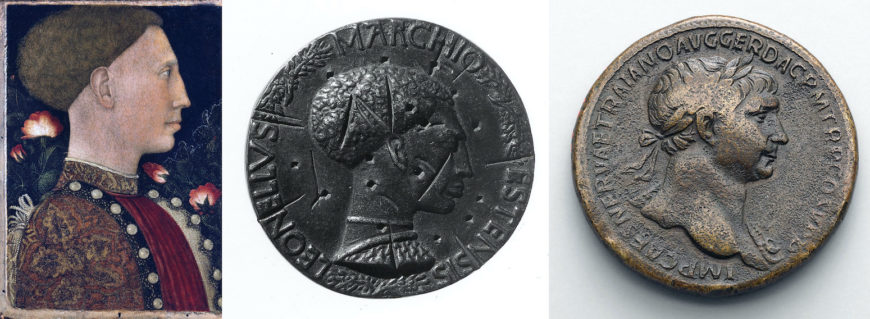
Left: Pisanello, Leonello d’Este, 1441, tempera on panel, 28 x 19 cm (Accademia Carrara); center: Pisanello, medal of Leonello d’Este, c. 1441–44 (possibly cast 16th century), yellowish copper alloy with dark brown patin. 6.5 cm diameter (The Metropolitan Museum of Art); right: sesterius of Trajan, 103–111, bronze, 3.4 x .4 cm (The Metropolitan Museum of Art)
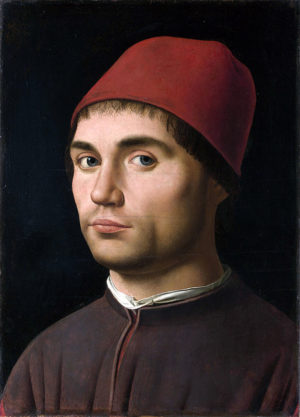
Antonello da Messina, Portrait of a Man, c. 1475–76, oil on poplar, 35.6 x 25.4 cm (The National Gallery)
Rulers such as Leonello were eager to associate themselves with the glory of ancient Rome and the profile format was borrowed directly from ancient coinage. The faces of the emperors of antiquity survived on the thousands of Roman coins prized by renaissance collectors. The profile format did eventually go out of style, largely replaced by the forward-facing three-quarter view popularized first in Northern Europe and then in Italy by the later fifteenth century (such as in Antonello da Messina’s portrait of a man).
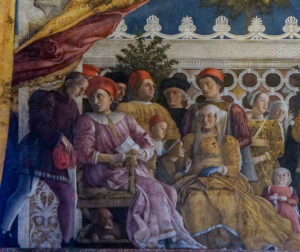
Andrea Mantegna, portrait of Ludovico Gonzaga (seated on the chair), in the Camera Picta (Camera degli Sposi), frescos in the ducal palace in Mantua, 1465–74 (photo: Lauren Kilroy-Ewbank, CC BY-NC-SA 2.0)
Not every artist could do what Pisanello did, and he was duly sought after for his skill. Even those artists greatly admired for their pictorial abilities, such as the renowned painter Andrea Mantegna, were not necessarily seen as skilled in the art of portraiture. As Ludovico Gonzaga, ruler of Mantua and patron of Mantegna, begrudgingly noted, “Andrea is a good master in other things, in portraits he could have more grace—in portraiture he does not do so well.” [1] Mantegna’s painted portraits were thought to be too life-like, presenting his sitters in unidealized reality—wrinkles, fat rolls, hunched backs and all. By contrast, Pisanello’s portraiture, such as his leonine Marquis of Ferrara, shows his sitters at their idealized best.
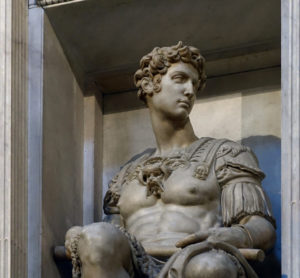
Michelangelo, portrait of Giuliano de’Medici, 1524-34, marble, tomb monument in the New Sacristy, Florence (photo: Steven Zucker, CC BY-NC-SA 2.0)
Successful portrait painting required the skills of a courtier as well as those of an artist. The artist must flatter the sitter he (by the sixteenth century, occasionally she) depicted without seeming to do so—the features depicted must reflect the desired “inner truth” of the sitter more than the accidents of nature’s surfaces. How a sitter wanted to be understood or remembered was as important as physical appearance, perhaps even more so. When asked why his sculpted portraits of the Medici dukes for their tombs in Florence looked nothing like the men in life, Michelangelo famously quipped that in centuries to come no one would know—or care—what they really looked like.
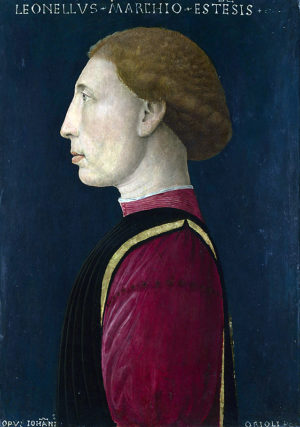
Giovanni da Oriolo, Leonello d’Este, c. 1447, egg tempera on panel, 57.6 x 39.5 cm (The National Gallery)
Numerous portraits of Leonello survive, some in paint, others in portrait medals, all with subtle variations on the same basic features presented in Pisanello’s painting. A roughly contemporaneous portrait of the Marquis by Giovanni da Oriolo is often noted in comparison with Pisanello’s work. The features are recognizably those associated with Leonello—bouffant hair-do, eagle-like nose, upright posture—and yet there are subtle differences.
In Giovanni’s work Leonello’s face is wider, his jaw is heavier, his lips protrude further, his nose is more elongated. In Pisanello’s able hands, these elements are softened, the features slimmed and refined: Leonello is presented as heroic and manly, elegant and graceful—the ideal humanist prince. Pisanello’s portrait is an early example of a new, even exploratory art form that would become one of the great innovations of the renaissance era.

